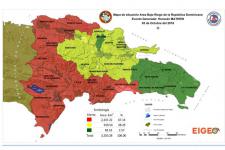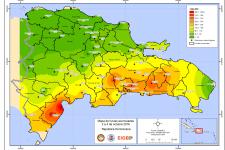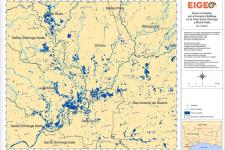


Hurricane Matthew impacted Haiti, the Dominican Republic and Jamaica on 03 October 2016. As a category 4 hurricane, it has generated floods in these countries. The National Emergency Commission of the Dominican Republic elevated a request for technical support to UN-SPIDER on 04 October 2016.
To support emergency response efforts, UNOOSA requested the Italian Space Agency to task its COSMO-Skymed satellite to acquire satelllite imagery of areas affected in Dominican Republic and Haiti. In addition, the National Emergency Commission of the Dominican Republic requested the activation of the International Charter Space and Major Disasters to acquire relevant space-based information to contribute to disaster response efforts.
Generation of relevant geospatial information is being conducted by the Inter-Institutional Geo-Spatial Information Team (EIGEO) that has been set up by the National Emergency Commission for this purpose since 2013. The EIGEO team is composed of professionals and experts from 14 government agencies, university institutes and NGOs. The EIGEO team was officially activated on 03 October 2016 to contribute to disaster response efforts in the Dominican Republic and in Haiti related to this hurricane.
The maps generated by the EIGEO team on the 3rd and 4th october shows that the south-eastern parts of the Dominican Republic was predominantly affected by the deadly hurrican Matthew. The eye of the hurricane is presented on the map with deep red colour, while the most powerful, destructive eyewall and feeder bands(rainbands) of the hurricane which are accompanied by heavy rains are represented in orange and yellow respectively.
The International Charter Space and Major Disasters was activated by USGS on 03 October 2016 to support emergency response efforts in Haiti. The Pacific Disaster Center has been nominated as Project Manager in this activation.
Links to data and maps:
More information on this Charter activation for the Dominican Republic can be found here.
More information on the Charter activation for Haiti can be found here.
More information on the Copernicus EMS activation for Haiti can be found here.
More information on the efforts of the Pacific Disaster Center in Haiti can be found here.
The Disaster and Risk Profile for the Dominican Republic can be found here.
The Reliefweb page for the Dominican Republic can be found here.
The Reliefweb page for Hurricane Matthew can be found here.
On the 4th and 5th October the Dominican republic was directly under the rain bands, causing it to recieve intense precipitation and storm surge leading to large floods. This can be seen on the map showing structure of hurricane Matthew when it arrived at Dominica Republic, the maps were generated by the EIGEO team.
The sitiution was similar for Haiti on 4th and 5th October which was also directly under the rain bands therefore recieving heavy precipitation, storms and storm surges as indicated in the structure of hurricane Matthew over Haiti by EIGEO team.
| Attachment | Tamaño |
|---|---|
| structure of hurricane Matthew when it arrived at Dominica Republic (7.8 MB) | 7.8 MB |
| structure of hurricane Matthew over Haiti (6.33 MB) | 6.33 MB |
| Pre-processed images generated from RADARSAT-2 with flooded area layer in blue indicating (172.91 KB) | 172.91 KB |
| Processed RADARSAT-2 flood maps with the digital elevation also integrated during hurricane matthew (187.65 KB) | 187.65 KB |
| Fully digitized map of the flooded region of Dominican Republic indicating flood extent (181.65 KB) | 181.65 KB |
